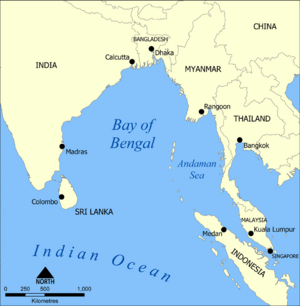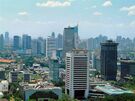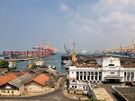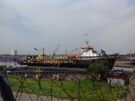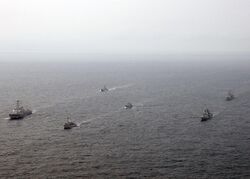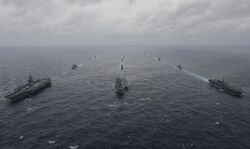Place:Countries of the Bay of Bengal
The countries of the Bay of Bengal include littoral and landlocked countries in South Asia and Southeast Asia that depend on the bay for maritime usage. Historically, the Bay of Bengal has been a highway of transport, trade, and cultural exchange between diverse peoples encompassing the Indian subcontinent, Indochinese peninsula , and Malay Archipelago. Today, the Bay of Bengal region is the convergence of two major geopolitical blocs- the Association of Southeast Asian Nations (ASEAN) and the South Asian Association for Regional Cooperation (SAARC). The Bay of Bengal Initiative for Multisectoral Technical and Economic Cooperation (BIMSTEC) promotes regional engagement in the area.
The Bay of Bengal countries are often categorized into a maritime subregion. The bay hosts vital shipping routes linking its littoral and landlocked hinterland with the Indian Ocean. Its sea bed is being explored and exploited for hydrocarbon reserves.
Littoral countries
 Bangladesh: The People's Republic of Bangladesh is the eighth-most populous country in the world. It is located at the northern apex of the Bay of Bengal, forming the largest and eastern part of the bay's historical namesake region, Bengal. It is hugely dependent on the bay for sources of nutrition (fish), shipping, energy, and employment.[1][2] The Bangladeshi port of Chittagong is one of the busiest ports on the bay. The Bangladeshi capital Dhaka hosts the headquarters of BIMSTEC.
Bangladesh: The People's Republic of Bangladesh is the eighth-most populous country in the world. It is located at the northern apex of the Bay of Bengal, forming the largest and eastern part of the bay's historical namesake region, Bengal. It is hugely dependent on the bay for sources of nutrition (fish), shipping, energy, and employment.[1][2] The Bangladeshi port of Chittagong is one of the busiest ports on the bay. The Bangladeshi capital Dhaka hosts the headquarters of BIMSTEC. India: The India n states of West Bengal, Odisha, Andhra Pradesh , and Tamil Nadu have coastlines on the Bay of Bengal. India's eastern military command is based in the port city of Kolkata, the capital of erstwhile British India. Two of India's busiest ports Chennai and Vizag are also located on the bay. In addition to mainland India's coastline, the Indian Union territory of the Andaman and Nicobar Islands is located on the bay. The islands are largely reserved as a base for the Indian military.[3]
India: The India n states of West Bengal, Odisha, Andhra Pradesh , and Tamil Nadu have coastlines on the Bay of Bengal. India's eastern military command is based in the port city of Kolkata, the capital of erstwhile British India. Two of India's busiest ports Chennai and Vizag are also located on the bay. In addition to mainland India's coastline, the Indian Union territory of the Andaman and Nicobar Islands is located on the bay. The islands are largely reserved as a base for the Indian military.[3] Indonesia: The northern tip of the Indonesian island of Sumatra, including the province of Aceh, forms the southeastern boundary of the Bay of Bengal.[4]
Indonesia: The northern tip of the Indonesian island of Sumatra, including the province of Aceh, forms the southeastern boundary of the Bay of Bengal.[4] Myanmar: Formerly known as Burma, Myanmar's entire coastline is located on the Bay of Bengal. Its largest city and commercial capital Yangon is located in the littoral Irrawaddy delta on the bay. Myanmar's Rakhine State forms a large part of the country's coastline. Rakhine State's provincial capital is the port city of Sittwe.
Myanmar: Formerly known as Burma, Myanmar's entire coastline is located on the Bay of Bengal. Its largest city and commercial capital Yangon is located in the littoral Irrawaddy delta on the bay. Myanmar's Rakhine State forms a large part of the country's coastline. Rakhine State's provincial capital is the port city of Sittwe. Sri Lanka: Dondra Head in southern Sri Lanka forms the southwestern boundary of the Bay of Bengal.[4] The coastline includes Sri Lanka's Eastern, Northern, and Southern provinces. The Sri Lankan ports of Jaffna, Trincomalee , and Hambantota are located on the bay. Western Sri Lanka's Colombo port relies on the bay's transshipment traffic.
Sri Lanka: Dondra Head in southern Sri Lanka forms the southwestern boundary of the Bay of Bengal.[4] The coastline includes Sri Lanka's Eastern, Northern, and Southern provinces. The Sri Lankan ports of Jaffna, Trincomalee , and Hambantota are located on the bay. Western Sri Lanka's Colombo port relies on the bay's transshipment traffic. Thailand: As a peripheral country,[4] Thailand's western coastline is linked with the Bay of Bengal through the Andaman Sea, a marginal sea of the Indian Ocean.
Thailand: As a peripheral country,[4] Thailand's western coastline is linked with the Bay of Bengal through the Andaman Sea, a marginal sea of the Indian Ocean.
Landlocked countries and regions
 Bhutan: The landlocked Himalayan kingdom of Bhutan is dependent on the Bay of Bengal as its sole maritime access route. Bhutan currently uses Indian and Bangladeshi seaports for maritime trade. Bhutan is dependent on the Indian port of Kolkata
Bhutan: The landlocked Himalayan kingdom of Bhutan is dependent on the Bay of Bengal as its sole maritime access route. Bhutan currently uses Indian and Bangladeshi seaports for maritime trade. Bhutan is dependent on the Indian port of Kolkata China: The Bay of Bengal's coastline with Myanmar has been described as China's "second coast".[5] The Sino-Myanmar pipelines transport oil and natural gas from the deep-water port of Kyaukpyu to Yunnan Province. The Tibet Autonomous Region also forms part of the Bay of Bengal's landlocked hinterland.
China: The Bay of Bengal's coastline with Myanmar has been described as China's "second coast".[5] The Sino-Myanmar pipelines transport oil and natural gas from the deep-water port of Kyaukpyu to Yunnan Province. The Tibet Autonomous Region also forms part of the Bay of Bengal's landlocked hinterland. India: Landlocked Northeast India's only maritime passage depends on the Bay of Bengal. The Kolkata Port in West Bengal, India serves this region. The landlocked states include Assam, Mizoram, Tripura, Meghalaya, Manipur, Nagaland and Arunachal Pradesh.
India: Landlocked Northeast India's only maritime passage depends on the Bay of Bengal. The Kolkata Port in West Bengal, India serves this region. The landlocked states include Assam, Mizoram, Tripura, Meghalaya, Manipur, Nagaland and Arunachal Pradesh. Nepal: The landlocked republic of Nepal forms part of the wider hinterland of the Bay of Bengal. Nepal has transit agreements with India and Bangladesh for the use of seaports.
Nepal: The landlocked republic of Nepal forms part of the wider hinterland of the Bay of Bengal. Nepal has transit agreements with India and Bangladesh for the use of seaports.
Other dependent countries
 Maldives: Although the Maldives is not located in the Bay of Bengal, its fishing industry depends on the bay. Fishing is one of the chief employment sectors in the Maldives.
Maldives: Although the Maldives is not located in the Bay of Bengal, its fishing industry depends on the bay. Fishing is one of the chief employment sectors in the Maldives. Malaysia: Peninsular Malaysia is located near the Bay of Bengal. The Malaysian fishing and international trade sectors depend on the Bay of Bengal.
Malaysia: Peninsular Malaysia is located near the Bay of Bengal. The Malaysian fishing and international trade sectors depend on the Bay of Bengal. Singapore: Singapore's economy relies significantly on container traffic from the littoral Bay of Bengal countries, which use the Port of Singapore for transshipment.
Singapore: Singapore's economy relies significantly on container traffic from the littoral Bay of Bengal countries, which use the Port of Singapore for transshipment.
Maritime history
Early history

Prince Vijaya, the first recorded king of Sri Lanka, traveled from ancient Vanga (Bengal) through the Bay of Bengal to the island of Lanka and colonized it. Ancient Malay chronicles record the sailor Buddha Gupta traveling from Bengal to the Malay Archipelago through the Bay of Bengal.[citation needed] Ptolemy's map refers to the Bay of Bengal as the Gulf of the Ganges.[6]
Hindu-Buddhist kingdoms in Southeast Asia depended on the Bay of Bengal for trade and cultural exchange. The South Indian Chola dynasty dominated the region in the 11th century, with records describing the Bay of Bengal as Chola's Lake.[7]
Islam in Southeast Asia also spread through the Bay of Bengal, by serving as a bridge between the Malay Archipelago and Indo-Islamic states in the subcontinent.[8][9]
In the 14th and 15th centuries, explorers like Ibn Battuta of Morocco, Niccolo De Conti of the Venetian Republic , and Admiral Zheng He of Imperial China ventured through the Bay of Bengal. The Maldives depended on the Bay of Bengal for its huge shell currency trade.[10]
In the 16th century, the Portuguese empire began traversing the sea routes of the Bay of Bengal. Portuguese maps referred to the bay as the "Gulf of Bengal".[11] The Burmese Empires and the Kingdom of Mrauk U were major powers in the Bay of Bengal. The Kingdom of Mrauk U engaged in a naval war with the Mughal Empire of India in 1666. In the 18th century, numerous European trading companies established settlements across the region.
In the 19th century, the British government established direct crown rule in the Indian subcontinent; while the Dutch government established supremacy in the Indonesian archipelago. Colonialism disrupted and ended the region's traditional maritime networks.
Modern era
In the early 20th century, shipping between British India and British Burma rapidly increased. Rangoon became one of the world's busiest ports for immigrant arrivals, ranking alongside New York City .[12] In Rangoon, thousands of Indian migrants arrived to settle in British Burma. The migration fostered strong economic links between India and Burma. British Burma's petroleum industry supplied much of India's petroleum demand. However, commercial links were disrupted during World War II, when Burma came under Japanese occupation. The Japanese took control of the Andaman Islands and used them as a penal colony. After the partition of India in 1947 and Burma's independence in 1948, there was a decline in Indo-Burmese commerce.
During the Indo-Pakistani War of 1971 over Bangladesh's independence, the Indian and Pakistani navies engaged in naval combat in the Bay of Bengal. A Pakistani submarine, the PNS Ghazi, sunk in the bay. In December 1971, the United States and Soviet Union mobilized naval strike groups around the Bay of Bengal.[13]
Bangladesh and Myanmar engaged in a naval standoff over disputed maritime territory in 2008. The two countries settled their maritime boundary dispute in 2012 at the International Tribunal for the Law of the Sea.[14] In 2014, India and Bangladesh resolved their maritime boundary disputes at a UN tribunal.[15]
The Rohingya refugee crisis, caused by persecution in Myanmar's Rakhine State, has been a major humanitarian and security challenge in the region.
Demographics
Population
According to Sunil S. Amrith, one in four people on earth live in the countries that border the Bay of Bengal. Its littoral areas — including coastal regions of eastern India, Bangladesh, Sri Lanka, Myanmar, Thailand, Malaysia, and Sumatra — are home to over half a billion people.[16]
| Rank | City | Country | Region/County | Population (urban) | ||
|---|---|---|---|---|---|---|
| 1 | Dhaka | Bangladesh | Dhaka Division | 18,898,000[17] | ||
| 2 | Kolkata | India | West Bengal | 14,617,882[18] | ||
| 3 | Bangkok | Thailand | Bangkok Province | 14,565,547[19] | ||
| 4 | Jakarta | Indonesia | Special Capital Region | 10,075,310[20] | ||
| 5 | Chennai | India | Tamil Nadu | 8,917,749[21] | ||
| 6 | Yangon | Myanmar | Yangon Region | 7,360,703[22] | ||
| 7 | Chittagong | Bangladesh | Chittagong Division | 4,009,423[23] | ||
| 8 | Colombo | Sri Lanka | Western Province | 2,323,826[24] | ||
| 9 | Gazipur City | Bangladesh | Dhaka Division | 1,820,374[25] | ||
| 10 | Mandalay | Myanmar | Mandalay Region | 1,726,889[22] | ||
| 11 | Narayanganj | Bangladesh | Dhaka Division | 1,636,441[25] | ||
| 12 | Khulna | Bangladesh | Khulna Division | 1,636,441[25] | ||
| 13 | Guwahati | India | Assam | 962,334[26] | ||
| 14 | Chiang Mai | Thailand | Chiang Mai Province | 960,906 | ||
| Sources: Census reports of Bangladesh, Thailand, India and Myanmar | ||||||
Economy
Statistical data (2021)
| Country | Nominal GDP | Purchasing power parity | Per capita | Currency |
|---|---|---|---|---|
| Bangladesh | $416.26 billion | $1.11 trillion | $2,520 | Bangladeshi taka |
| Bhutan | $2.547 billion | $7.701 billion | $3,117 | Bhutanese ngultrum |
| China | $19.912 trillion | $30.18 trillion | $14,096 | Renminbi |
| India | $3.535 trillion | $11.745 trillion | $2,543 | Indian rupee |
| Indonesia | $1.150 trillion | $3.530 trillion | $4,224 | Indonesian rupiah |
| Myanmar | $78 billion | $258 billion | $1,422 | Myanmar kyat |
| Nepal | $36.084 billion | $122.62 billion | $1,236 | Nepalese rupee |
| Sri Lanka | $84.532 billion | $306.997 billion | $3,830 | Sri Lankan rupee |
| Thailand | $536.841 billion | $1,340 billion | $7,674 | Thai baht |
Fishing
Fisheries is an important economic activity in countries with coasts along the Bay of Bengal, particularly in Sri Lanka, India, Bangladesh, Myanmar, Thailand, and Indonesia. The fishing industry in the Bay of Bengal area provides employment and sustenance to large numbers of people. Based on a recent estimate, the total number employed on a full-time basis in fisheries in the area covered by the Bay of Bengal is 1.85 million. In addition, a large number of people are engaged in fishing as a part-time activity. The total population in the households of those engaged in fishing, full-time or part-time, in this area, is estimated at ten million.[27]
In recent years, the fishing industry has developed into an important earner of foreign exchange through the export of marine and aquatic products. In Bangladesh, fish exports account for 15 percent of the total export earnings. Though the percentage contribution of the fisheries sector to the total export earnings of the country is yet marginal in the other countries in absolute terms, the export earnings have been increasing very fast. As export items, fish and fish products are very important, as the net earnings from these products are extremely high, a result of their being almost one hundred percent local resource-based.[27]
The increased production of marine fish has come primarily through the motorization of traditional craft, the introduction of new craft, and the introduction and popularization of new types of synthetic gear, which have replaced traditional gear. It is in Thailand alone that the private/commercial sector has taken the initiative of introducing and extending craft and gear; there has been very little state support or intervention in these activities in this country.[27] The increasing emphasis accorded to the development of coastal aquaculture is another feature common to almost every country in the region. In countries such as Bangladesh, Sri Lanka, and India, a primary reason for the increased emphasis on coastal aquaculture is the increase in foreign exchange earnings generated from shrimp farming.[27]
Tourism
Thailand's Andaman Coast is the largest hub of tourism in the region. Sri Lanka's tourism industry has seen growth despite decades of civil war in the country's north. Bangladesh and India have significantly developed their domestic tourism industries, such as in Cox's Bazar. South India's renowned temple cities, such as Tanjore, are located near the Bay of Bengal. In Bangladesh, the notable mosque city of Bagerhat is located near the Bay of Bengal. Myanmar has prioritized tourism development, particularly in cultural heritage sites like Mrauk U and Bagan.
Transport
The Port of Colombo in Sri Lanka handles over 5 million twenty-foot equivalent units (TEU)s of container traffic. The Port of Chittagong in Bangladesh handles over 2 million TEUs of container traffic. The Port of Chennai in India handles around 1.7 million TEUs of container traffic. Ports that handle over 100,000 TEUs of container traffic include the Port of Kolkata, Tuticorin Port Trust, the Port of Yangon, the Port of Mongla , and the Port of Vizag. Colombo is the busiest seaport in BIMSTEC. Chittagong is the busiest seaport on the Bay of Bengal coastline,[28] followed by Chennai, Kolkata, Tuticorin, Yangon, Visakhapatnam, and Mongla.[29][30][31][32][33] Sittwe Port and Hambantota are other important ports in the region.
Thailand and India signed direct coastal shipping agreements with Bangladesh in 2016.[34][35]
Busiest seaports (2015-16)
| Rank | Port City | Harbour | Country | Container traffic (TEU) | ||
|---|---|---|---|---|---|---|
| 1 | Colombo | Port of Colombo | Sri Lanka | 5 million [36] | ||
| 2 | Chittagong | Port of Chittagong | Bangladesh | 2.2 million[37] | ||
| 3 | Chennai | Port of Chennai | India | 1.5 million[29] | ||
| 4 | Kolkata | Port of Kolkata | India | 630,000[38] | ||
| 5 | Tuticorin | Tuticorin Port Trust | India | 560,000 [39] | ||
| 6 | Visakhapatnam | Visakhapatnam Port | India | 291,000[40] | ||
| 7 | Yangon | Port of Yangon | Myanmar | 244,888[32] | ||
| 8 | Mongla | Port of Mongla | Bangladesh | 100,000[41] | ||
Oil and gas
The Bay of Bengal has large untapped oil and natural gas reserves.[42] Geologists believe the region holds many of the largest reserves in the Asia-Pacific.[43] Currently, there are few offshore platforms operating in the Bay of Bengal. The Shwe offshore platform is operated by Daewoo International for supplies to China through Myanmar.[44] Bangladesh's Sangu platform, which opened in 1994, was shut down in 2013.[45] India's Reliance Industries began production in an offshore block near India's coast in 2009.[46]
Security and strategic importance
Common security space
The BIMSTEC countries view the Bay of Bengal as a common security space. The first conference of national security chiefs in the region was held in 2017.[47]
Non-traditional security challenges
The Bay of Bengal has non-traditional security challenges of piracy, human trafficking, terrorist networks, and drug smuggling, which has led to greater cooperation between the navies of Bangladesh, India, the United States , and Thailand.
Sino-Indian rivalry
The Bay of Bengal is a prime zone of strategic competition between two of Asia's largest countries- China and India. An example is in the case of Myanmar, where the Sino-Myanmar pipelines and Chinese-funded Kyaukpyu port project were followed by the Kaladan Multi-Modal Transit Transport Project funded by India. China and India have jostled for strategic influence in Bangladesh, Sri Lanka and Nepal. The Sri Lankan port of Hambantota was built by the Chinese.[48][49][50]
Japanese initiatives
In 2014, Japanese Prime Minister Shinzo Abe announced an initiative to develop an industrial corridor in Bangladesh to strengthen Japan's economic footprint in the region. The initiative is termed the "Bay of Bengal Industrial Growth Belt" (BIG-B).[51] Japan is keen to establish a maritime surveillance center for the Indian Ocean region in Sri Lanka.[52]
Bangladesh, Thailand, and Myanmar depend on China as a source of military equipment. Some analysts have speculated that an arms race emerging between these countries.[53][54]
Joint exercises
The United States, a major Indo-Pacific naval power, conducts the Cooperation Afloat Readiness and Training (CARAT) involving Bangladesh, Brunei, Cambodia, Indonesia, Malaysia, the Philippines, Singapore and Thailand. In 2011, CARAT was held off the coast of southeastern Bangladesh. The Malabar naval exercise is held by the navies of the United States, India, and Japan .
Natural disaster management
The Bay of Bengal region has seen some of modern history's worst natural disasters, such as the 1970 Bhola cyclone and the 2004 Indian Ocean tsunami. The international community often mobilizes naval forces to assist in relief operations in the aftermath of devastating natural disasters, most recently after Cyclone Sidr and Cyclone Nargis.
See also
- Global Southeast
- Eastern South Asia
- Andaman Sea
- Andaman and Nicobar Islands
- History of Indian influence on Southeast Asia
- Kra Isthmus
- Maritime Silk Road
References
- ↑ Hafez Ahmed (15 March 2012). "BD wins maritime suit against Myanmar". The Financial Express. https://today.thefinancialexpress.com.bd/public/first-page/bd-wins-maritime-suit-against-myanmar.
- ↑ Ravi Prasad, Special to Hart Energy (2014-11-19). "Bangladesh Focuses On Bay Of Bengal | Exploration & Production". Epmag.com. http://www.epmag.com/bangladesh-focuses-bay-bengal-762006.
- ↑ "With strong navy and army base, 'Andamans should be developed as commercial hub' : FYI, News - India Today". Indiatoday.intoday.in. 2017-05-16. http://indiatoday.intoday.in/story/andamans-strong-navy-army-base-developed-commercial-hub/1/955173.html.
- ↑ 4.0 4.1 4.2 Verlaan, Philomene A. (1959-08-21). "Bay of Bengal | bay, Indian Ocean". Britannica.com. https://www.britannica.com/place/Bay-of-Bengal.
- ↑ "China's Second Coast: Implications for Northeast India | Institute for Defence Studies and Analyses". Idsa.in. 2014-06-19. http://www.idsa.in/idsacomments/ChinasSecondCoast_ngoswami_190614.
- ↑ Thomas Suárez (31 March 1992). Shedding the Veil: Mapping the European Discovery of America and the World. World Scientific. p. 35. ISBN 978-981-4505-79-6. https://books.google.com/books?id=XqjsCgAAQBAJ&pg=PT35.
- ↑ Nagapattinam to Suvarnadwipa: Reflections on the Chola Naval Expeditions to Southeast Asia. Singapore: Institute of Southeast Asian Studies. 2009. p. 80. ISBN 978-981-230-937-2. https://books.google.com/books?id=2swhCXJVRzwC&pg=PA80.
- ↑ Sunil S. Amrith (7 October 2013). Crossing the Bay of Bengal. Harvard University Press. p. 37. ISBN 978-0-674-72846-2. https://books.google.com/books?id=8eWwAAAAQBAJ&pg=PA37.
- ↑ Formichi, Chiara (2020). Islam and Asia: A History. Cambridge University Press. pp. 75–79. ISBN 978-1-107-10612-3. https://books.google.com/books?id=t-fWDwAAQBAJ.
- ↑ Boomgaard, P. (1 January 2008). "Linking Destinies: Trade, Towns and Kin in Asian History". BRILL – via Google Books.
- ↑ Sunil S. Amrith (7 October 2013). Crossing the Bay of Bengal. Harvard University Press. p. 18. ISBN 978-0-674-72846-2. https://books.google.com/books?id=8eWwAAAAQBAJ&pg=PA18.
- ↑ "The Bay of Bengal: Rise and Decline of a South Asian Region". YouTube. 2014-06-16. https://www.youtube.com/watch?v=JzBh71QMuqw.
- ↑ Rais, R.B (1987), The Indian Ocean and the Superpowers, Rowman & Littlefield, ISBN:0-389-20695-4.
- ↑ "INTERNATIONAL TRIBUNAL FOR THE LAW OF THE SEA". 2012. https://www.itlos.org/fileadmin/itlos/documents/cases/case_no_16/C16_Judgment_14_03_2012_rev.pdf.
- ↑ Habib, Haroon (9 July 2014). "Bangladesh wins maritime dispute with India". The Hindu. http://www.thehindu.com/news/national/bangladesh-wins-maritime-dispute-with-india/article6191797.ece.
- ↑ Sunil S. Amrith (2013-10-13). "The Bay of Bengal, in Peril From Climate Change". The New York Times. https://www.nytimes.com/2013/10/14/opinion/the-bay-of-bengal-in-peril-from-climate-change.html.
- ↑ "Dhaka Population 2017". World Population Review. 2016-11-19. http://worldpopulationreview.com/world-cities/dhaka-population/.
- ↑ "Provisional Population Totals, Census of India 2011". http://censusindia.gov.in/2011-prov-results/paper2/data_files/india2/Million_Plus_UAs_Cities_2011.pdf.
- ↑ "Table 1 Population by sex, household type and household by type, average size of private household by region and area: 2010". Statistic tables, NSO website. National Statistics Office. http://service.nso.go.th/nso/nso_center/project/table/files/C-pop/2553/000/00_C-pop_2553_000_010000_00100.xls.
- ↑ "Masuk". data.jakarta.go.id. 2015-03-30. http://data.jakarta.go.id/user/login?came_from=http%3A%2F%2Fdata.jakarta.go.id%2Fdataset%2Fdata-jumlah-penduduk-dki-jakarta.
- ↑ "Tamil Nādu (India): State, Major Agglomerations & Cities - Population Statistics in Maps and Charts". Citypopulation.de. http://www.citypopulation.de/India-TamilNadu.html.
- ↑ 22.0 22.1 "Census Main Report (UNION) - ENGLISH.pdf - Google Drive". https://drive.google.com/file/d/0B067GBtstE5TeUlIVjRjSjVzWlk/view.
- ↑ "Population & Housing Census-2011: Union Statistics". http://www.bbs.gov.bd/WebTestApplication/userfiles/Image/National%20Reports/Union%20Statistics.pdf.
- ↑ Britannica Book of the Year 2014 - Encyclopaedia Britannica, Inc. - Google Books. March 2014. ISBN 9781625131713. https://books.google.com/books?id=LccRAwAAQBAJ&pg=PA726. Retrieved 2017-07-23.
- ↑ 25.0 25.1 25.2 "Bangladesh: Divisions and Urban Areas - Population Statistics, Maps, Charts, Weather and Web Information". http://citypopulation.de/Bangladesh-UA.html.
- ↑ "Guwahati City Population Census 2011 | Assam". Census2011.co.in. http://www.census2011.co.in/census/city/191-guwahati.html.
- ↑ 27.0 27.1 27.2 27.3 "Fisheries in the Bay of Bengal". http://www.fao.org/3/ad480e/ad480e01.pdf.
- ↑ "Chittagong breaks record, tops 2 million TEU a year sooner than targeted - PORTS". SeaNews. http://www.seanews.com.tr/chittagong-breaks-record-tops-2-million-teu-a-year-sooner-than-targeted/158288/.
- ↑ 29.0 29.1 "Chennai Port trust : performance during the year". Pib.nic.in. 2016-04-16. http://pib.nic.in/newsite/PrintRelease.aspx?relid=145881.
- ↑ "Highlights of Achievements for 2015-2016". http://www.kolkataporttrust.gov.in/showfile.php?layout=2&lid=1714.
- ↑ "Vizag port poised to emerge as transhipment hub". The Hindu. 2016-04-10. http://www.thehindu.com/news/cities/Visakhapatnam/vizag-port-poised-to-emerge-as-transhipment-hub/article8457021.ece.
- ↑ 32.0 32.1 "Container port traffic (TEU: 20 foot equivalent units) | Data". Data.worldbank.org. http://data.worldbank.org/indicator/IS.SHP.GOOD.TU.
- ↑ "Bangladesh port expands as shippers avoid Chittagong". 2012-06-05. http://www.joc.com/port-news/asian-ports/bangladesh-port-expands-shippers-seek-chittagong-alternative_20170607.html.
- ↑ "Bangladesh-Thailand in Multi-Billion Trade Boom? - Port Technology International". 2016-02-10. https://www.porttechnology.org/news/bangladesh_thailand_in_multi_billion_trade_boom.
- ↑ "India And Bangladesh Sign Standard Operating Procedure To Operationalize Agreement On Coastal Shipping". 2016-12-29. http://www.marineinsight.com/shipping-news/india-and-bangladesh-sign-standard-operating-procedure-to-operationalize-agreement-on-coastal-shipping/.
- ↑ "Colombo Port creates history with 5 m TEU mark". Ft.lk. 2015-12-21. http://www.ft.lk/article/511147/Colombo-Port-creates-history-with-5-m-TEU-mark.
- ↑ "Chittagong Port ranks 76th in Lloyd's Register". Dhaka Tribune. http://www.dhakatribune.com/bangladesh/2016/10/08/chittagong-port-ranks-76th-lloyds-register/.
- ↑ "India's major ports see 6.7 percent growth in container volumes". JOC.co. 7 April 2015. http://www.joc.com/port-news/asian-ports/port-nhava-sheva/india’s-major-ports-see-67-percent-growth-container-volumes_20150407.html.
- ↑ "India's major ports see 6.7 percent growth in container volumes". Joc.com. 2012-06-05. http://www.joc.com/port-news/asian-ports/port-nhava-sheva/india%E2%80%99s-major-ports-see-67-percent-growth-container-volumes_20150407.html.
- ↑ "Vizag port poised to emerge as transhipment hub". The Hindu. 2016-04-10. http://www.thehindu.com/news/cities/Visakhapatnam/vizag-port-poised-to-emerge-as-transhipment-hub/article8457021.ece.
- ↑ "Bangladesh port expands as shippers avoid Chittagong". Joc.com. 2012-06-05. http://www.joc.com/port-news/asian-ports/bangladesh-port-expands-shippers-seek-chittagong-alternative_20170607.html.
- ↑ Sajeeb Wazed. "Investment in Bay of Bengal Will Unlock Potential for Billions". The Diplomat. https://thediplomat.com/2017/07/investment-in-bay-of-bengal-will-unlock-potential-for-billions/.
- ↑ Jack Detsch. "Bangladesh: Asia's New Energy Superpower?". The Diplomat. https://thediplomat.com/2014/11/bangladesh-asias-new-energy-superpower/.
- ↑ "SHWE platform installed off Myanmar". http://www.offshore-mag.com/articles/print/volume-73/issue-02/departments/vessels-rigs-surface-systems/shwe-platform-installed-off-myanmar.html.
- ↑ "RPT-Santos closes down Bangladesh's only offshore gas field". Reuters. 2013-10-01. https://www.reuters.com/article/bangladesh-offshore-energy-idUSL4N0HR42Y20131001.
- ↑ "Reliance Fires Up Gas Production from India's KG-D6 Block | Rigzone". 2009-04-02. http://www.rigzone.com/news/oil_gas/a/74634/reliance_fires_up_gas_production_from_indias_kgd6_block.
- ↑ "Bimstec countries see Bay of Bengal as common security space". The Independent (Dhaka). http://www.theindependentbd.com/post/86572.
- ↑ "The Rise of the Bengal Tigers: The Growing Strategic Importance of the Bay of Bengal | East-West Center". 2015-06-04. http://www.eastwestcenter.org/events/the-rise-the-bengal-tigers-the-growing-strategic-importance-the-bay-bengal.
- ↑ "The Bay of Bengal as a New Strategic Space - Carnegie India - Carnegie Endowment for International Peace". Carnegie India. http://carnegieindia.org/2017/02/07/bay-of-bengal-as-new-strategic-space-event-5509.
- ↑ David Brewster (2014-12-02). "The Bay of Bengal: the Indo-Pacific's new zone of competition | The Strategist". https://www.aspistrategist.org.au/the-bay-of-bengal-the-indo-pacifics-new-zone-of-competition/.
- ↑ "The Initiative of BIG-B (The Bay of Bengal Industrial Growth Belt) | Bangladesh | Countries & Regions". 2014-06-16. https://www.jica.go.jp/bangladesh/english/office/activities/initiative.html.
- ↑ "Japan keen on making Sri Lanka a centre for strategic maritime surveillance". Bdnews24.com. 2017-04-20. http://bdnews24.com/neighbours/2017/04/20/japan-keen-on-making-sri-lanka-a-centre-for-strategic-maritime-surveillance.
- ↑ "ASEAN's new arms race: nations scramble to rearm as concerns over security grow". https://www.aseantoday.com/2017/01/aseans-new-arms-race-nations-scramble-to-rearm-as-concerns-over-security-grow/.
- ↑ Saurav Jha (2014-04-23). "The Bay of Bengal Naval Arms Race". The Diplomat. https://thediplomat.com/2016/12/the-bay-of-bengal-naval-arms-race/. Retrieved 2017-07-25.
 |
